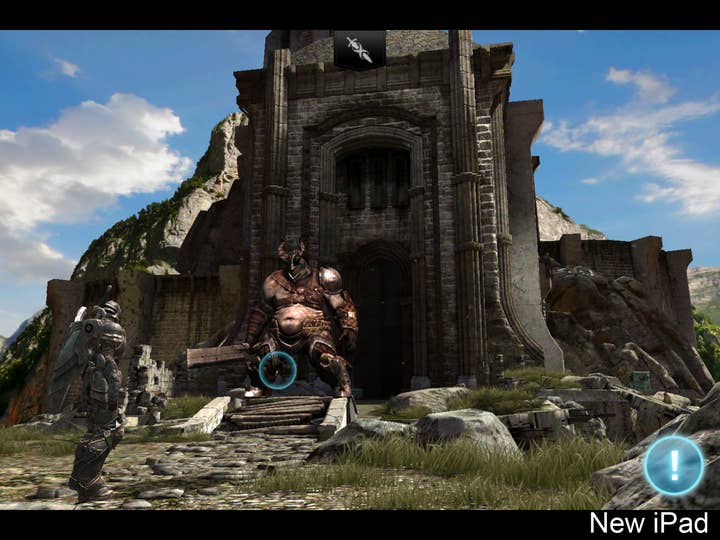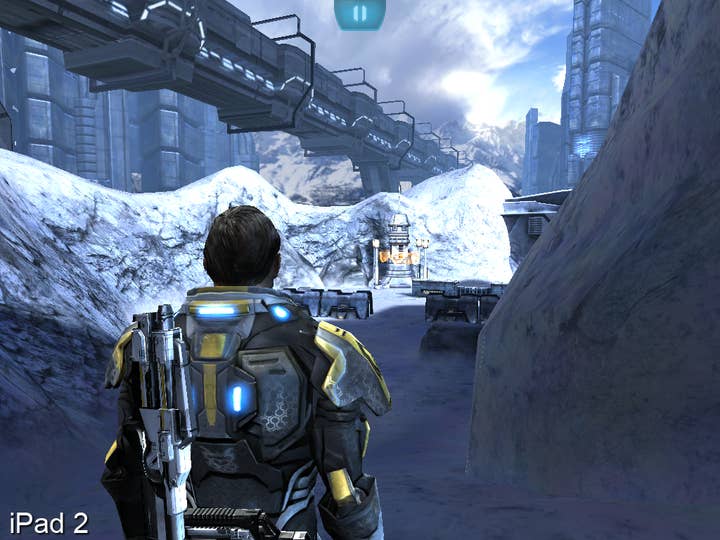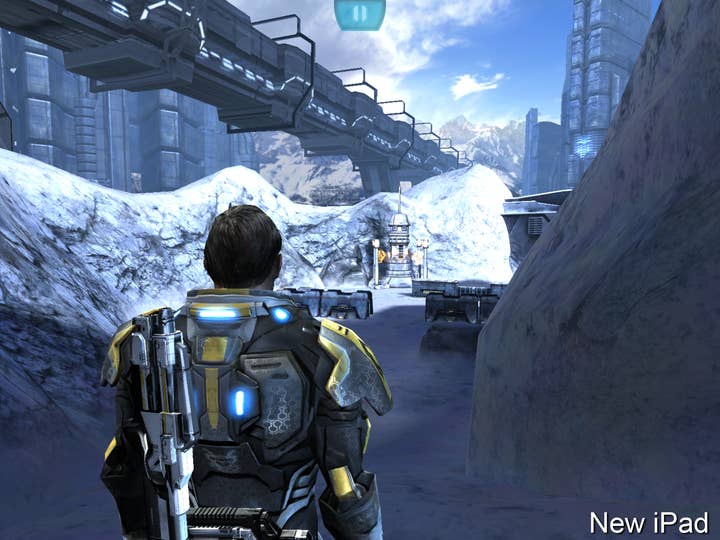Tech Focus: The New iPad and the Evolution of iOS Gaming
Digital Foundry on how Apple has defined the mobile market and the generational hardware leap ahead.
Mobile processing and graphics power has increased by orders of magnitude over the last few years and few companies have done more than Apple to showcase the gaming capabilities of this exciting, powerful, energy-efficient hardware. Remarkably, we're now months away from a generational leap in mobile performance even more radical than the 5x jump in GPU performance we saw with the arrival of the iPad 2.
"The recent release of Apple's 'New iPad' is best described as the last great hurrah for the current generation of ARM and PowerVR hardware and the focus is clearly on the new Retina display."
Next year, everything changes: new architectures roll out and there's a strong possibility we will finally see mobile parts theoretically surpass the performance of the current generation of HD consoles - and Apple will almost certainly be at forefront of this revolution. However, the recent release of Apple's "New iPad" is best described as the last great hurrah for the current generation of ARM and PowerVR hardware - this year the focus is clearly on the new Retina display.
In terms of overall form factor, the latest iOS tablet looks remarkably similar to the existing iPad 2, which continues to be sold alongside the new one at a $100/£70 discount. The overall design aesthetic is effectively identical with the only noticeable changes being that the new tablet is noticeably heavier and slightly "fatter". When the new A5X processor is put through its paces with challenging 3D content, you'll also notice that the tablet can get rather warm too, something that can become much more pronounced if you have the iPad inside a case.
All of these compromises are present in order to accommodate the new Retina screen supplied by Samsung, which quadruples resolution from the iPad's traditional 1024x768 up to an extraordinary 2048x1536. The screen almost certainly sucks up a lot more juice and the A5X processor also adds a significant hit to battery life. Apple's somewhat expensive solution is to seriously beef up the battery power provision - the 25 watt-hour batteries of iPad 2 give way to 42.5 watt-hour lithium-ion cells in the new tablet.




The physical make-up of the A5X processor in itself is also rather surprising: many suspected that Apple would double up on both CPU and GPU cores for its new device, but in the event only the graphics technology has been upgraded, with a 2x boost in power over the iPad 2, being tasked with maintaining 4x the resolution. This results in some compromises: Retina upgrades to graphics-intensive titles like Mass Effect: Infiltrator and Infinity Blade 2 don't actually address the full 2048x1536 potential of the screen, running at sub-native resolution - but still offering something approaching a 2x boost in detail compared to the iPad 2 versions.
Other titles like Galaxy on Fire 2 HD, Modern Combat 3 and Sky Gamblers: Air Supremacy support full Retina res, but also appear to possess a more inconsistent frame-rate compared to the same games running on the older tablet. An interesting compromise is Vector Unit's Riptide GP which has a graphics menu option allowing players to scale up resolution to their liking while acknowledging that doing so impacts frame-rate.
Perhaps the biggest surprise about the technical make-up of A5X is just how big it is, occupying 163mm2 of silicon, fabricated on a 45nm process (again by Samsung). This is seriously large for a mobile device - over double the area of NVIDIA's Tegra 3 SoC. In actual fact, the size of the chip is almost a match for Intel's 2010 vintage quad core Q9500 desktop processor - produced at a similar 45nm process. Most commentators in the tech press - myself included - believed that Apple would drop down a 32nm or 28nm process, but in the event the firm decided simply to go bigger and fit higher capacity batteries: a choice which must be costing Apple a fortune, especially bearing in mind that the base price of the iPad hasn't increased over the launch price of its predecessor.
"Apple's strategy with the new iPad seems to be to accommodate the Retina screen whatever the cost: CPU, batteries and RAM have all required costly upgrades to power the 2048x1536 display."
On the one hand, it's hard to avoid the idea that has Apple has been forced to throw everything including the kitchen sink at the new tablet in order to make that beautiful screen work resulting in a much more expensive BOM (bill of materials) but on the other hand, it's difficult to imagine any other manufacturer with the audacity, vision - and the deep pockets - required to do the same. The obvious conclusion is that Apple is not taking its success for granted, and it isn't growing complacent in its complete domination of the mobile market. Even with its third generation tablet, it's continuing to push the boat out, setting the standards that its competition aspires to.
The release of the new iPad also means that there's good news for value-conscious consumers too. Those who aren't bowled over by the retina screen can now buy the iPad 2 for £330 - or even around the £300 mark if you manage to catch a special promotion from the likes of online retailer eBuyer. Functionally identical to the new iPad in almost every way (aside from the camera and a fairly useless voice recognition add-on for the keyboard), iPad 2 remains near the top of the pile in the crowded tablet marketplace, only beaten by its own replacement and more niche, specialist products like the Asus Transformer Prime. New iPad and iPad 2 have proven to be virtually interchangeable in my own household (the new screen gets a few "ooohs" every now and again but the family are happy to use either device) perhaps suggesting that Apple now has a brace of superb products at two price-points. The price reduction on the older tablet also serves to make worthy Android competitors including the recently released £300 Huawei Media Pad now look distinctly overpriced.
A dual tablet product line-up may yet be bolstered by the arrival of a third, budget-orientated product. Intriguingly, developer builds of the latest iOS reveal the apparent existence of another iPad 2 running the same revised single-core A5 chip we see in the new 1080p-capable Apple TV. Bearing in mind that the firm's set-top box is sold for just $99, a 7-inch Kindle Fire competitor at $199-$250 is an interesting option for the manufacturer.
Update: Recent reports from Anandtech reveal that the new CPU is a 32nm die-shrink of the original A5, with a single core disabled on the Apple TV - the "new" tablet being a revision of the current iPad 2, potentially with improved battery life.
So, where next for Apple and the mobile technology it has spurred on with its yearly revisions? Traditionally, new iPad tech has always ended up in the next iPhone - the current 4S features the same A5 processor as iPad 2, running 20 per cent slower to conserve power. However, A5X seems to be designed especially with the new iPad's screen in mind, and it's hard to imagine why an iPhone would require a quad core GPU when display resolution is already at the Retina level, and coping very nicely indeed with the A5's existing SGX543 MP2. Anandtech posits the interesting theory that the existing A5 will be die-shrunk to 28nm/32nm for improved battery life and gain 4G support: which would make the new iPhone another revision as opposed to a groundbreaking new product.
Anand also suggests that the next-gen processor - A6 - features a dual core Cortex A15 in combination with the PowerVR Rogue architecture from IMG, and it set to debut in next year's tablet, something I mentioned in a recent analysis of the remarkable rumour-mongering surrounding what was then referred to as the iPad 3.
However, a die-shrunk A5 with 4G modem surely leaves the next iPhone potentially looking rather anaemic. Bearing in mind that Sony is looking at exactly the same combo of next-gen ARM/IMG tech for its upcoming NovaThor chipset due at the end of the year, perhaps Apple will choose to debut A6 in the new iPhone instead. Anand believes the timing is too aggressive for that, but if the new iPad demonstrates anything, it's that if Apple wants something to happen badly enough, nothing can get in its way.
An A15/Rogue combo is a seriously big deal. We've seen hints and demos of AAA content running on mobile platforms before - Lost Planet 2 running on Tegra 3 for example - but certainly in terms of GPU horsepower, Rogue should be able to match and exceed performance from the Xenos graphics core found in the Xbox 360 - indeed, the new IMG chip should also feature additional DirectX 11 graphics features and sources tell us that it blitzes performance of the SGX543 hardware in the current iPad 3 and PlayStation Vita. In theory, next-gen iOS devices - including the much-rumoured Apple TV for the living room - could potentially become a target for AAA cross-platform game development.
"Next-gen mobile tech, slated to arrive next year, finally sees graphics power catch up with - and perhaps even exceed - the capabilities of the Xbox 360 and PlayStation 3. The iPad 4 could conceivably become a target platform for AAA development."
If the horsepower is there, the concept of AAA crossover then becomes a matter of storage and input devices. In terms of controllers, rumours are already circulating that Apple is investigating an add-on for more traditional gaming: something I would see as essential if the iOS gaming platform is to migrate into the living room in the form of a full TV set, but would be a nice addition for the other devices too with Bluetooth being the logical interface there.
Increasing storage would be very useful indeed for handling more complex games, but even with the current gradual evolution of the iOS platforms, available space clearly needs to increase. With the transition to Retina technology on iPad, we are already seeing file sizes for games expand rapidly - 2D art and higher resolution textures have seen anything up to a 2x rise in download sizes in some cases: great for those with higher capacity third gen iPads, but bloat for everyone else.
With the latest iPad, a 16GB entry level is suddenly looking very restrictive and I'd hope that this would rise to 32GB in the transition to next-gen. In a world where branded 16GB USB flash drives now cost less than £7.50 and where Apple is content to spend so much money on high capacity batteries, standards-setting displays and enormous (in mobile terms) processor packages, hopefully this is only a matter of time.
But make no mistake, Apple has clear designs on expanding its gaming empire, having dominated the mobile sector with the right products at the right time, backed by the most powerful graphics hardware in the market. In a week where Apple's market cap has exceed $600bn and where it accounts for 36 per cent of S&P's total 500 Index Q1 earnings, the sky's the limit. It's no longer a case of whether Apple will bring its own brand of gaming to the home, it's a matter of when and how...









